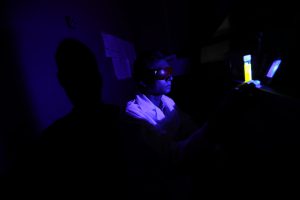UT blue light research named a Top 100 science paper of 2018
December 21st, 2018 by Christine BillauA scientific discovery at The University of Toledo was selected as one of the top 100 most talked about scholarly publications in the world this year.
Altmetric, a data company that tracks and tallies the year’s 100 most attention-grabbing studies, chose UT’s blue light research as No. 76 in its annual list that provides a picture of the influence and reach of academic work.
According to Altmetric’s analysis, “The blue light coming from your computers, phones and tablets is doing damage to your retinas, and this study elaborates on the mechanisms by which blue light causes retinal degradation. The study has elicited a lot of interest, concern and conflicting advice across popular media about how best to protect your eyes.”

Dr. Ajith Karunarathne examined toxic oxygen generation by retinal during blue light exposure.
Dr. Ajith Karunarathne, assistant professor in the Department of Chemistry and Biochemistry, earned international attention in August for discovering how blue light triggers cell death in the presence of retinal, a light harvesting molecule in the eye.
His research about blue light-induced cell damage reached more than 400 million people around the world through hundreds of news outlets, including Popular Science, USA Today, CNN Headline News/HLN, The Guardian, Teen Vogue, Forbes and Newsweek.
Altmetric not only tracks news media mentions, but also social media shares and policy documents. Overall, the company tracked more than 25 million mentions of 2.8 million research outputs in 2018.
In its demographic breakdown of the blue light research, Altmetric shows that while scientists and physicians shared UT’s news on Twitter, most of the tweets – 84 percent – came from members of the public.
“My group is composed of extremely talented and hardworking graduate and undergraduate students, and this recognition is a tribute to their passion in advancing science,” Karunarathne said. “Our published work is an example of how multidisciplinary research can unveil hidden molecular details of crucial cellular mechanisms.”
In this case, UT chemists explored how the combination of blue light and retinal – the abundant chromophore in the eye – damages cells.
Karunarathne’s lab found that blue light exposure causes retinal to trigger reactions that generate poisonous chemical molecules in photoreceptor cells.
After his research showing retinal-generated toxicity by blue light was published in the journal Scientific Reports in July, Karunarathne said he received feedback from people who shared their experiences on how occupational blue light exposure is a major health concern for them.
“It is an honor to study a process that people care so much about,” Karunarathne said. “In this high-tech world, we are being exposed to blue light continuously. It is crucial to find how and when blue light becomes damaging.”
Karunarathne’s lab currently is measuring light coming from television, cell phone and tablet screens to get a better understanding of how the cells derived from the eye respond to everyday blue light exposure.
“We are looking into the details of the discovered mechanism and investigating if commonly used light-emitting devices have the potential to trigger toxic chemical reactions in cells,” Karunarathne said.
Christine Billau is
UT's Media Relations Specialist. Contact her at 419.530.2077 or christine.billau@utoledo.edu.
Email this author | All posts by
Christine Billau

